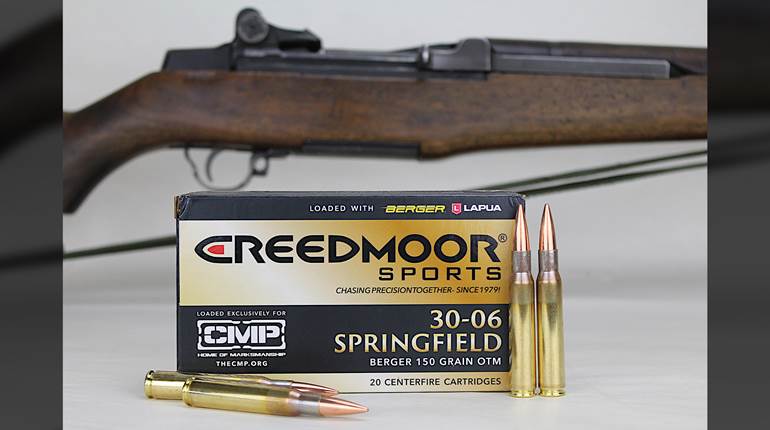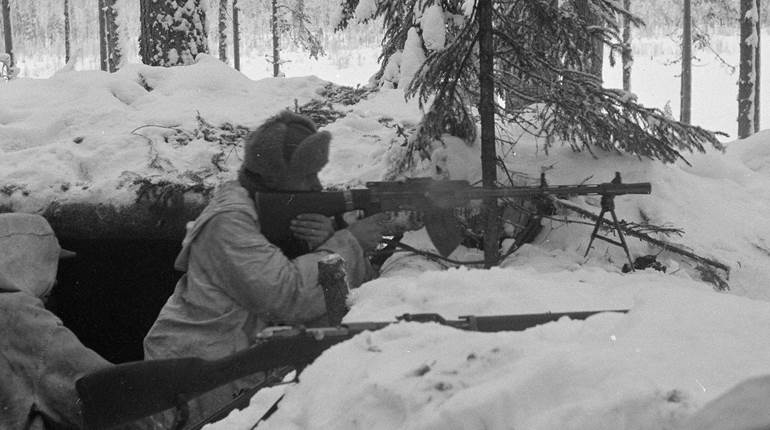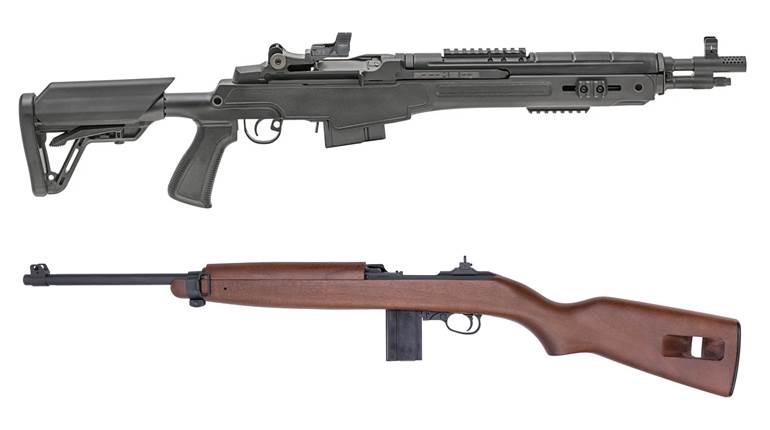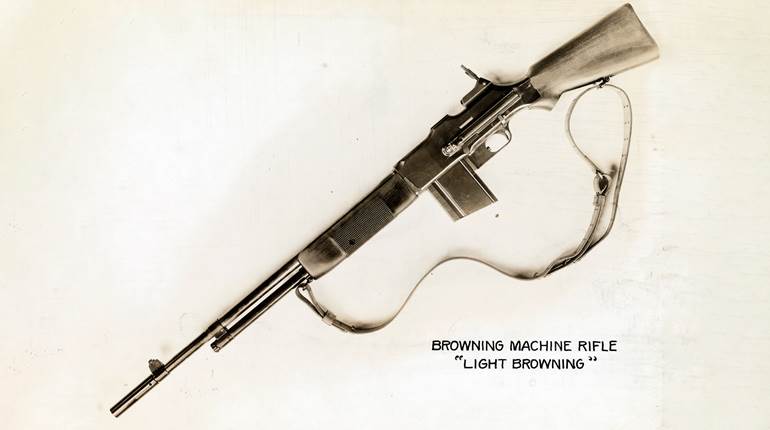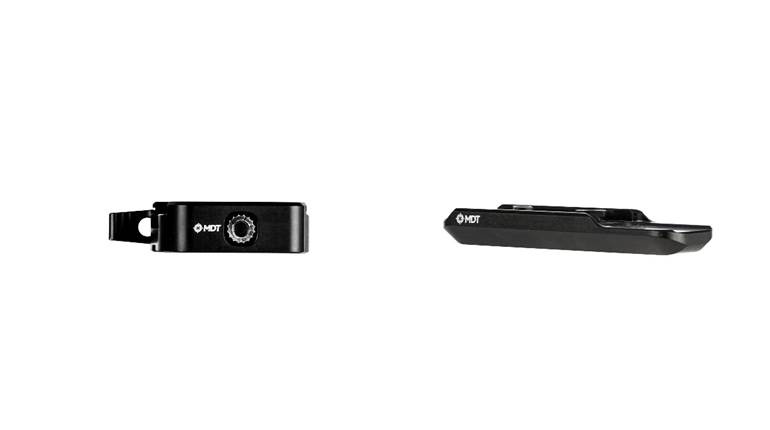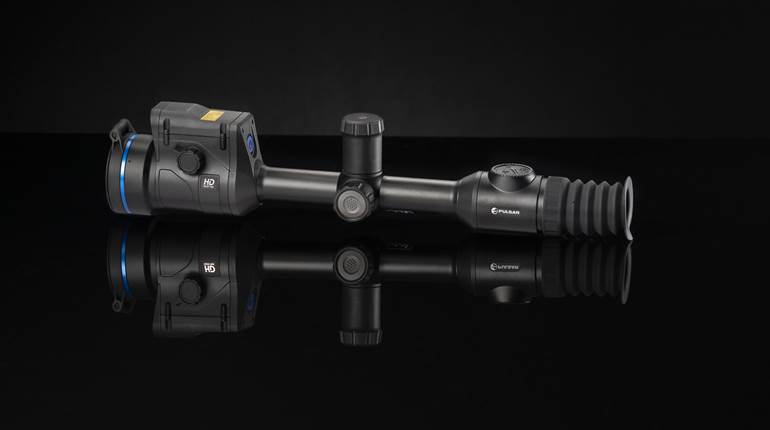
American paratroopers generally used the same small arms as their infantry comrades. The most notable exception was the airborne-specific U.S. Model M1A1 “Paratrooper” Carbine (top). It employed a folding stock and could be fitted into a scabbard when actually parachuting. Firepower was also a concern for the lightly armed airborne, so Thompsons were heavily used.
This article was first published in American Rifleman, August 2001 Among the most elite outfits of the United States Army of World War II were the airborne units. The American paratroopers served bravely and with distinction in a number of campaigns during the war including the assault on Sicily, the invasion of France and “Operation Market Garden” along with some smaller-scale operations in the Pacific. At the conclusion of the war there were several fully operational airborne divisions in the U.S. Army, and the American armed forces had the strongest and best-equipped airborne units in the history of warfare.
Among the most elite outfits of the United States Army of World War II were the airborne units. The American paratroopers served bravely and with distinction in a number of campaigns during the war including the assault on Sicily, the invasion of France and “Operation Market Garden” along with some smaller-scale operations in the Pacific. At the conclusion of the war there were several fully operational airborne divisions in the U.S. Army, and the American armed forces had the strongest and best-equipped airborne units in the history of warfare.
Prior to Pearl Harbor, the War Department authorized the organization of airborne units for the U.S. Army. America’s active involvement in World War II resulted in a large expansion of the Army’s airborne units. With few exceptions, the arms issued to American paratroopers were the same as carried by their “straight leg” infantry brethren. These include crew-served weapons, such as .30-cal. machine guns and mortars, as well as small arms.
PISTOLS
M1911A1
There was a larger percentage of handguns utilized by airborne troops than by standard infantry. The compactness and that fact the that a handgun could easily be carried during his descent made pistols a very desirable part of the paratrooper’s armament. Even if his standard arm should be lost, he would still have his pistol.
The handgun used by virtually all paratroopers was the standard “.45 automatic.” The M1911A1 was the variant being manufactured during that period, but large numbers of M1911 pistols of World War I (and earlier) vintage were also used during the Second World War. Many of the M1911 pistols were arsenal overhauled prior to, and during, World War II.
Small numbers of “Substitute Standard” handguns such as the Colt and S&W M1917 .45 ACP revolvers saw limited use, but the overwhelming type of pistol used in airborne units during World War II was the M1911/M1911A1 .45.
RIFLES M1 Garand
M1 Garand
Although the semi-automatic U.S. M1 Garand rifle had been adopted in 1936, the rifle was in short supply during the early days of World War II. Many infantry units were not fully armed with the Garand until well into 1943, and the bolt-action U.S. M1903 Springfield saw a lot of use during the first couple of years of the war.
Since firepower was very important for the relatively lightly armed airborne units, the paratroopers typically received preference regarding issuance of the M1 rifle. There was some limited use of the bolt-action M1903 rifle in the airborne units primarily as a grenade launching platform.
In any event, the Garand was the standard service rifle of the American paratrooper, and the rifle saw wide use in all U.S. airborne operations of the war. The M1’s chief drawback was its bulk and weight of around 10 lbs.
A padded canvas carrying case was developed for airborne operations. Dubbed the “Griswold bag,” the case allowed the M1 rifle to be safely carried during a parachute descent. The stock was removed when fitted into the Griswold bag, which greatly increased the rifle’s compactness. Once on the ground, the M1 could be quickly and easily reassembled and brought into action with a minimum of delay. Despite its usefulness, it should be noted that the Griswold bag was not always utilized, and some paratroopers jumped with fully assembled rifles.
The reliability and firepower of the M1 made it the arguably the best infantry rifle of World War II, and it served the paratroopers and other infantry troops extremely well.

M1 .30-Cal. & M1A1. 30-Cal. Carbines
The .30-cal. M1 carbine was adopted in 1941 as a supplemental arm intended to replace the pistol and submachine gun. While it did neither, the carbine was manufactured in greater quantities than any other U.S. military small arm of the World War II with more than 6 million being manufactured from late 1941 to mid 1945.
The compact, lightweight and fast-firing carbine naturally appealed to the airborne troops. Eventually, 10 firms were granted carbine production contracts including the developer of the design, the Winchester Repeating Arms Co.
In order to make the carbine even more adaptable for use by paratroopers, a version with a folding stock was adopted. That model, developed by Inland Manufacturing Division of General Motors (the largest manufacturer of carbines), featured a wooden stock fitted with a pistol grip and a hinged metal buttstock assembly that folded to the left side of the stock. With the stock folded, the carbine was extremely compact, yet the stock could be opened instantly. Except for the special stock, the M1A1 carbine was identical to the standard M1 carbine. That variant was standardized as the “Carbine, Cal. .30, M1A1” in May 1942. Deliveries began in October of the same year to the 82nd and 101st Airborne Divisions.
A total of 140,591 M1A1 carbines were manufactured by Inland by the time production of the variant ceased in December of 1944. The M1A1 carbine was used in all U.S. airborne operations of World War II. It is interesting to note that this is the only U.S. Army small arm designed specifically for airborne use. It should be noted, however, that some standard M1 carbines were also used by paratroopers during the war.
After the war, the carbine, including the M1A1 variant, remained in use by the U.S. military and most were subsequently arsenal overhauled (rebuilt) and fitted with updated parts. Today original M1A1 carbines are highly sought-after collectibles and a number of reproduction arms of this type may be encountered. The M1A1 is a classic American airborne arm of World War II.
SUBMACHINE GUNS
The nature of airborne operations placed a greater emphasis on firepower. While the semi-automatic M1 rifle and .30 cal. carbines helped provide the needed firepower, fully automatic submachine guns also saw widespread use in the American airborne units of World War II.
M1928A1, M1 & M1A1 Thompson Submachine Guns
The standard submachine gun in U.S. Army service at the beginning of the war was the famed M1928A1 Thompson. It was chambered for the standard .45 ACP cartridge used with the M1911 pistol.
When the U.S. Army parachute units were being formed just prior to World War II, the Thompson was logically seen as a valuable arm for such use. While heavy and expensive to manufacture, the Thompson provided a lot of firepower and was rugged and durable. Initially, it was equipped with 50 round drum magazines as well as 20-round box magazines. The drum magazines dropped from widespread use after 1943 due their weight, noise and complexity. A 30-round magazine was developed and saw wide issue later in the war.
At the beginning of World War II, the M1928A1 Thompson was in production by the Auto Ordnance Corp. and the Savage Arms Co. As production demands increased, the manufacturers sought ways to reduce the gun’s manufacturing time and cost. A greatly simplified variant, the M1, was developed. This model differed from the M1928A1 Thompson in many ways including elimination of the Cutts Compensator on the barrel, a simple stamped metal rear sight to replace the expensive and unnecessary Lyman sight and moving the charging handle from the top of the receiver to the right side. Other differences included a permanently attached stock and changes in the receiver that prevented use of the 50-round drum magazine. Later, the design was further simplified by the elimination of the hammer and the substitution of a fixed firing pin on the bolt. This final variant was given the “M1A1” designation.
The M1 and M1A1 Thompsons could be manufactured much faster and cheaper than the M1928A1, but all variants saw widespread use throughout the war. The Thompson was a favorite of many paratroopers because of its firepower and ruggedness.

M3 and M3A1 Submachine Guns
While the Thompson was a popular arm with many of its users, even the simplified versions were time-consuming and expensive to produce.
The American arms designer George Hyde developed a very simple and easily manufactured submachine gun design chambered for the .45 ACP cartridge. After testing and evaluation, the it was adopted as the “Submachine Gun, Caliber .45, M3.” The M3 was soon (unofficially) dubbed the “grease gun” because of its resemblance to the mechanic’s tool. The M3 submachine gun was constructed of stamped and welded sheet metal. A production contract was granted to the Guide Lamp Division of General Motors. The M3 could be manufactured much faster than the Thompson and at a mere fraction of the cost.
The M3 initially offended the sensibilities of many in the American military who were used to the superbly made Thompson. Among the first combat uses of the “grease gun” was the drop of Normandy preceding the “D-day” invasion. However, the M3 was still something of a novelty at that time and most of the “All Americans” of the 82nd and “Screaming Eagles” of the 101st who jumped into France that historic night carrying submachine guns were armed with Thompsons rather than “grease guns.” Later in the war, an improved version of the “grease gun” was adopted as the “M3A1.” The chief difference was the elimination of the M3’s cocking handle, which was replaced by a simple slot in the bolt that allowed it to be withdrawn by simply inserting a finger. The M3A1 was also produced during World War II by Guide Lamp.
After the war, the Thompson was soon dropped from service while the M3A1 replaced it as the standard U.S. military submachine gun. Amazingly, limited numbers are still in use today!
Browning Automatic Rifle (BAR)
The standard squad automatic weapon of the U.S. Army during World War II was the venerable M1918A2 Browning Automatic Rifle (BAR). Although rather heavy at 20 plus lbs., the BAR was a reliable arm and provided much-needed firepower to infantry units. The firepower of the BAR was especially valuable to the airborne units, as it was often the only automatic arm available to the paratroopers.
The BAR fired the same .30-cal. (.30-’06 Sprg.) cartridge as the M1 and M1903 rifles and fed from a 20-round, detachable box magazine. The BAR had a bipod to make firing from the prone position easier, although the bipod was often removed to reduce weight and make it a bit less cumbersome.
Despite its bulk, the BAR was popular with the paratroopers of World War II, and it was widely used in all the American airborne operations of the war. Today, most veterans, including paratroopers, remember the BAR with admiration and being that it is one of the most highly-regarded small arms of the Second World War.
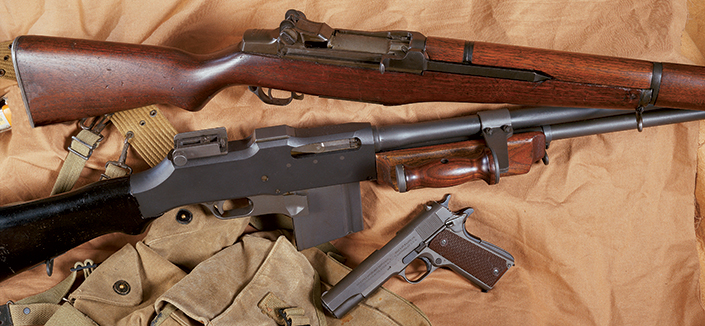
 U.S. Marine Corps Parachute Units
U.S. Marine Corps Parachute Units
Although the U.S. Army’s airborne divisions are well known, the U.S. Marine Corps also organized some parachute units. Immediately prior to Pearl Harbor, the Marines formed some small (battalion size) parachute units. The Marine paratroopers, sometimes referred to as “Para Marines,” were selected from volunteers and received rigorous training including jump school. Although never deployed in combat via airdrop, the Marine parachutists saw action in a number of campaigns in the Solomons including Gavutu, Tulagi, Guadalcanal and Bougainville.
It was recognized that a submachine gun could be a very valuable arm for the Marine airborne units. The Model 50 Reising submachine gun was adopted by the Marine Corps early in World War II primarily because of a shortage of the standard M1928A1 Thompson. The Reising saw widespread use by the Marine Corps early in World War II, especially during the Guadalcanal campaign. The Reising was a lightweight and accurate submachine gun that fired from a closed bolt.
The Model 55 Reising was a variant of the M50 Reising fitted with a folding wire stock, and the compensator on the barrel as used with the M50 Reising was eliminated. This made for a very compact “package” for airborne operations. The M55 was issued to all Marine Corps parachute units.
While the Reisings worked fine on the firing range, they malfunctioned with alarming regularity under combat conditions. A number of them were reportedly discarded on Guadalcanal because of their propensity to malfunction. The Reisings were withdrawn from use before the end of the war when sufficient numbers of other submachine guns, including Thompsons, became available.
In order to have sufficient firepower, the Marine Corps parachute units also procured a number of Model of 1941 Johnson Light Machine Guns. In addition to the Johnson Light Machine Gun, the Marine parachute units also procured a limited number of Model of 1941 Johnson semi-automatic rifles. As the military use of these models was recently covered in these pages (July 1999, p. 34) we will dispense with a full description of them here. As the war progressed the Marine paratroopers utilized other arms including M1 rifles, BARs and M1A1 carbines. The “Para Marines” were absorbed into other Marine Corps units when the First Parachute Regiment was disbanded.
Today, the story of the Marine parachute units is sometimes overlooked when considering the elite American units of World War II.
—Bruce N. Canfield












